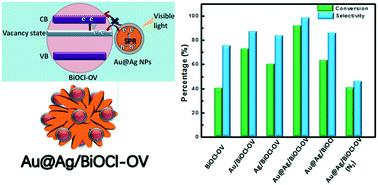当前位置:
X-MOL 学术
›
CrystEngComm
›
论文详情
Our official English website, www.x-mol.net, welcomes your feedback! (Note: you will need to create a separate account there.)
Design of Au@Ag/BiOCl–OV photocatalyst and its application in selective alcohol oxidation driven by plasmonic carriers using O2 as the oxidant
CrystEngComm ( IF 3.1 ) Pub Date : 2020-09-17 , DOI: 10.1039/d0ce01246g Huiqin An 1, 2, 3, 4 , Congying Deng 2, 3, 4, 5 , Yang Sun 1, 2, 3, 4 , Zhaotao Lv 2, 3, 4, 5 , Lifang Cao 1, 2, 3, 4 , Shunyuan Xiao 1, 2, 3, 4 , Lizhi Zhao 2, 3, 4, 6 , Zhen Yin 4, 7, 8, 9
CrystEngComm ( IF 3.1 ) Pub Date : 2020-09-17 , DOI: 10.1039/d0ce01246g Huiqin An 1, 2, 3, 4 , Congying Deng 2, 3, 4, 5 , Yang Sun 1, 2, 3, 4 , Zhaotao Lv 2, 3, 4, 5 , Lifang Cao 1, 2, 3, 4 , Shunyuan Xiao 1, 2, 3, 4 , Lizhi Zhao 2, 3, 4, 6 , Zhen Yin 4, 7, 8, 9
Affiliation

|
The hot holes produced by plasmonic noble metals have a mild oxidizing ability and provide an ideal alternative for photocatalytic selective oxidation. In this work, BiOCl with oxygen vacancies (BiOCl–OV) was photosensitized to the visible spectrum using plasmonic Au@Ag nanoparticles (NPs) to study photocatalytic selective alcohol oxidation using O2 as the oxidant. In the Au@Ag/BiOCl–OV system, the Au@Ag NPs consisting of a plasmonic Au core and covered by a very thin Ag shell were distributed on BiOCl spheres with the assistance of 3-aminopropyl-triethoxysilane (APTES). The combination of Au@Ag NPs and BiOCl–OV into one system endowed it with remarkable advantages in photocatalytic selective oxidation. Firstly, strong O2-adsorption capacity was achieved on the BiOCl–OV surface due to the presence of oxygen vacancies that serve as active sites. Secondly, the electron–hole generation capability is enhanced due to the extended optical absorption properties and amplified electromagnetic (EM) field effect that originated from the surface plasmon resonance (SPR) coupling effect of Au and Ag. Thirdly, the enhanced separation efficiency of hot electrons and holes was achieved through the trapping of hot electrons by the oxygen vacancies. The aforesaid, resulted in the remarkable enhancement of Au@Ag/BiOCl–OV as a photocatalyst in the selective oxidation of benzyl alcohol to benzaldehyde. We believe that the present strategy based on the plasmonic effect would be a significant contribution in the design and preparation of efficient photocatalysts for the selective oxidation.
中文翻译:

Au @ Ag / BiOCl–OV光催化剂的设计及其在以O2为氧化剂的等离子体载体驱动的选择性醇氧化中的应用
由等离激元贵金属产生的热孔具有适度的氧化能力,并为光催化选择性氧化提供了理想的选择。在这项工作中,使用等离子Au @ Ag纳米颗粒(NPs)将具有氧空位的BiOCl(BiOCl–OV)光敏化到可见光谱,以研究使用O 2作为氧化剂的光催化选择性醇氧化。在Au @ Ag / BiOCl–OV系统中,借助于3-氨基丙基-三乙氧基硅烷(APTES),由等离子Au核组成并被非常薄的Ag壳覆盖的Au @ Ag NPs分布在BiOCl球上。Au @ Ag NPs和BiOCl–OV的组合成为一个系统,使其在光催化选择性氧化方面具有显着优势。首先,强O 2由于存在作为活性位点的氧空位,因此在BiOCl-OV表面实现了吸附能力。其次,由于Au和Ag的表面等离振子共振(SPR)耦合效应产生的扩展的光吸收特性和放大的电磁场效应,增强了电子空穴的产生能力。第三,通过氧空位俘获热电子,提高了热电子和空穴的分离效率。上述结果导致Au @ Ag / BiOCl-OV作为光催化剂在苯甲醇选择性氧化为苯甲醛中的显着增强。
更新日期:2020-10-19
中文翻译:

Au @ Ag / BiOCl–OV光催化剂的设计及其在以O2为氧化剂的等离子体载体驱动的选择性醇氧化中的应用
由等离激元贵金属产生的热孔具有适度的氧化能力,并为光催化选择性氧化提供了理想的选择。在这项工作中,使用等离子Au @ Ag纳米颗粒(NPs)将具有氧空位的BiOCl(BiOCl–OV)光敏化到可见光谱,以研究使用O 2作为氧化剂的光催化选择性醇氧化。在Au @ Ag / BiOCl–OV系统中,借助于3-氨基丙基-三乙氧基硅烷(APTES),由等离子Au核组成并被非常薄的Ag壳覆盖的Au @ Ag NPs分布在BiOCl球上。Au @ Ag NPs和BiOCl–OV的组合成为一个系统,使其在光催化选择性氧化方面具有显着优势。首先,强O 2由于存在作为活性位点的氧空位,因此在BiOCl-OV表面实现了吸附能力。其次,由于Au和Ag的表面等离振子共振(SPR)耦合效应产生的扩展的光吸收特性和放大的电磁场效应,增强了电子空穴的产生能力。第三,通过氧空位俘获热电子,提高了热电子和空穴的分离效率。上述结果导致Au @ Ag / BiOCl-OV作为光催化剂在苯甲醇选择性氧化为苯甲醛中的显着增强。



























 京公网安备 11010802027423号
京公网安备 11010802027423号